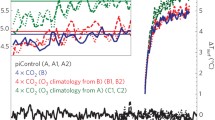Abstract
We review the methodologies used to quantify climate feedbacks in coupled models. The method of radiative kernels is outlined and used to illustrate the dependence of lapse rate, water vapor, surface albedo, and cloud feedbacks on (1) the length of the time average used to define two projected climate states and (2) the time separation between the two climate states. Except for the shortwave component of water vapor feedback, all feedback processes exhibit significant high-frequency variations and intermodel variability of feedback strengths for sub-decadal time averages. It is also found that the uncertainty of lapse rate, water vapor, and cloud feedback decreases with the increase in the time separation. The results suggest that one can substantially reduce the uncertainty of cloud and other feedbacks with the accumulation of accurate, long-term records of satellite observations; however, several decades may be required.





Similar content being viewed by others
References
Allan RP (2006) Variability in clear-sky longwave radiative cooling of the atmosphere. J Geophys Res 111:D22105. doi:10.1029/2006JD007304
Bony S, Dufresne J-L (2005) Marine boundary layer clouds at the heart of tropical cloud feedback uncertainties in climate models. Geophys Res Lett 32:L20806. doi:10.1029/2005GL023851
Bony S et al (2006) How well do we understand and evaluate climate change feedback processes? J Clim 19:3445–3482
Cess RD et al (1990) Intercomparison and interpretation of climate feedback processes in 19 atmospheric general circulation models. J Geophys Res 95(D10):16601–16615
Chung E-S, Yeomans D, Soden BJ (2010a) An assessment of climate feedback processes using satellite observations of clear-sky OLR. Geophys Res Lett 37:L02702. doi:10.1029/2009GL041889
Chung E-S, Soden BJ, Sohn B-J (2010b) Revisiting the determination of climate sensitivity from relationships between surface temperature and radiative fluxes. Geophys Res Lett 37:L10703. doi:10.1029/2010GL043051
Colman R (2003) A comparison of climate feedbacks in general circulation models. Clim Dyn 20:865–873
Colman R, McAvaney B (2009) Climate feedbacks under a very broad range of forcing. Geophys Res Lett 36:L01702. doi:10.1029/2008GL036268
Dessler AE (2010) A determination of the cloud feedback from climate variations over the past decade. Science 330:1523–1527
Dessler AE, Wong S (2009) Estimates of the water vapor climate feedback during El Niño-Southern Oscillation. J Clim 22:6404–6412
Dessler AE, Zhang Z, Yang P (2008) Water-vapor climate feedback inferred from climate fluctuations, 2003–2008. Geophys Res Lett 35:L20704. doi:10.1029/2008GL035333
Hansen J, Lacis A, Rind D, Russell G, Stone P, Fung I, Ruedy R, Lerner J (1984) Climate sensitivity: analysis of feedback mechanisms, in climate processes and climate sensitivity. AGU, Washington, pp 130–163
John VO, Soden BJ (2007) Temperature and humidity biases in global climate models and their impact on climate feedbacks. Geophys Res Lett 34:L18704. doi:10.1029/2007GL030429
Murphy JM (1995) Transient response of the Hadley Centre coupled ocean-atmosphere model to increasing carbon dioxide. Part III: analysis of global-mean response using simple models. J Clim 8:496–514
Murphy DM, Solomon S, Portmann RW, Rosenlof KH, Forster PM, Wong T (2009) An observationally based energy balance for the Earth since 1950. J Geophys Res 114:D17107. doi:10.1029/2009JD012105
National Research Council (2007) Earth science and applications from space: national imperatives for the next decade and beyond. The National Academies Press, Washington
Senior CA, Mitchell JFB (2000) The time-dependence of climate sensitivity. Geophys Res Lett 27:2685–2688
Shell KM, Kiehl JT, Shields CA (2008) Using the radiative kernel technique to calculate climate feedbacks in NCAR’s Community Atmospheric Model. J Clim 21:2269–2282
Soden BJ, Held IM (2006) An assessment of climate feedbacks in coupled ocean-atmosphere models. J Clim 19:3354–3360
Soden BJ, Broccoli AJ, Hemler RS (2004) On the use of cloud forcing to estimate cloud feedback. J Clim 17:3661–3665
Soden BJ, Held IM, Colman R, Shell KM, Kiehl JT, Shields CA (2008) Quantifying climate feedbacks using radiative kernels. J Clim 21:3504–3520
Wetherald RT, Manabe S (1988) Cloud feedback processes in a general circulation model. J Atmos Sci 45:1397–1415
Zhang MH, Hack JJ, Kiehl JT, Cess RD (1994) Diagnostic study of climate feedback processes in atmospheric circulation models. J Geophys Res 99:5525–5537
Acknowledgments
We would like to thank two anonymous reviewers for their constructive and valuable comments which led to an improved version of the manuscript. We also thank Bruce Wielicki and David Young of NASA Langley Research Center for valuable discussion. This research was supported by a grant from the NASA/CLARREO Program and the NOAA Climate Program Office.
Author information
Authors and Affiliations
Corresponding author
Rights and permissions
About this article
Cite this article
Chung, ES., Soden, B.J. & Clement, A.C. Diagnosing Climate Feedbacks in Coupled Ocean–Atmosphere Models. Surv Geophys 33, 733–744 (2012). https://doi.org/10.1007/s10712-012-9187-x
Received:
Accepted:
Published:
Issue Date:
DOI: https://doi.org/10.1007/s10712-012-9187-x




